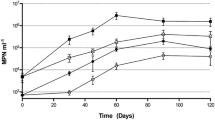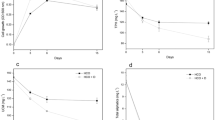Abstract.
The marine cyanobacteria Oscillatoria salina Biswas, Plectonema terebrans Bornet et Flahault and Aphanocapsa sp. degraded Bombay High crude oil when grown in artificial seawater nutrients as well as in plain natural seawater. Oil removal was measured by gravimetric and gas chromatographic methods. Around 45–55% of the total fractions of crude oil (containing 50% aliphatics, 31% waxes and bitumin, 14% aromatics and 5% polar compounds) were removed in the presence of these cultures within 10 days. Between 50% and 65% of pure hexadecane (model aliphatic compound) and 20% and 90% of aromatic compounds (anthracene and phenantherene) disappeared within 10 days. Mixed cultures of the three cyanobacterial species removed over 40% of the crude. Additionally, these cultures formed excellent cyanobacterial mats when grown in mixed cultures, and thus have the potential for use in mitigating oil pollution on seashores, either individually or in combination.
Similar content being viewed by others
Author information
Authors and Affiliations
Additional information
Received revised: 29 June 2001
Electronic Publication
Rights and permissions
About this article
Cite this article
Raghukumar, .C., Vipparty, .V., David, .J. et al. Degradation of crude oil by marine cyanobacteria. Appl Microbiol Biotechnol 57, 433–436 (2001). https://doi.org/10.1007/s002530100784
Received:
Accepted:
Issue Date:
DOI: https://doi.org/10.1007/s002530100784




